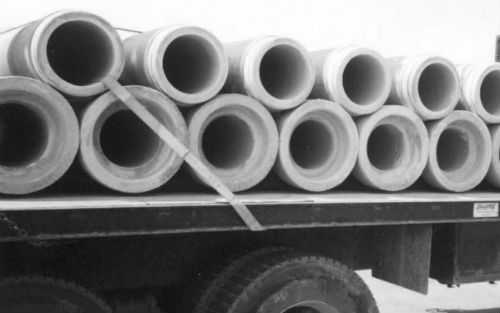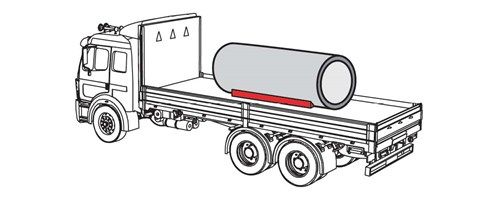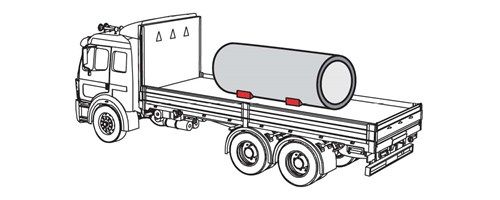Note: Your are not logged in. We can not keep your scores or track your progress unless you Register and Log In
Driver's Handbook on Cargo Securement - Chapter 7: Concrete Pipe Loaded Crosswise
What Does This Section Cover?

The specific requirements for concrete pipe apply to the transportation of certain concrete pipe loaded crosswise on a platform trailer or vehicle.
What is exempt from these specific requirements?
Follow general cargo securement requirements (Section 2) when transporting the following pipe:
- Concrete pipe that is grouped together into a single rigid article and may not roll.
- Concrete pipe loaded in a sided vehicle or container.
- Concrete pipe eyes vertical and concrete pipe loaded lengthwise.
What is covered under these specific requirements?
Any concrete pipe loaded crosswise on a platform trailer or vehicle that is not exempt.
Securing Concrete Pipe
To make sure that concrete pipe does not roll or slide:

Load pipe as compactly as possible.
Immobilize symmetrically stacked pipes by securing them in groups.
Use blocking systems and tie-downs to increase the effect of friction.
General tie-down requirements
The aggregate working load limit of all tie-downs on any group of pipe must be more than half the total weight of all pipes in the group.
Run a properly tensioned tie-down through a pipe in an upper tier or over lengthwise tie-downs. It will secure all the pipe beneath it on which the tie-down causes pressure.
Blocking requirements
Blocking must prevent the pipe from rolling or rotating.
Blocking may be one or more pieces placed at equal distances from the center of a pipe
There are two blocking options:
Blocking Option #1

Place one piece of blocking so that it extends at least half the distance from the center to each end of the pipe.
Blocking Option #2

Place two pieces of blocking at the outside quarter points.
Blocking must be:
- Placed against the pipe
- Secured to prevent it from moving out from under the pipe.
Timber blocking must have a minimum nominal dimension of 10 x 15 cm (4 x 6 in).
Multiple-Choice Questions:
What is the minimum aggregate WLL for a group of concrete pipe weighing 16,000 lbs?
- 8,001 lbs
- 5,000 lbs
- 7,999 lbs
- 10,000 lbs
General tiedown requirements
The aggregate working load limit of all tiedowns on any group of pipe must be more than half the total weight of all pipes in the group.
What is the minimum nominal dimension of timber blocking used to secure concrete pipe?
- 8 x 10 in
- 2 x 4 in
- 4 x 6 in
- Half the diameter of the pipe
Blocking must be:
- Placed against the pipe
- Secured to prevent it from moving out from under the pipe.
Timber blocking must have a minimum nominal dimension of 10 x 15 cm (4 x 6 in).
Within the requirements for concrete pipe, which of these requires specific securement methods?
- Concrete pipe eyes vertical and concrete pipe loaded lengthwise.
- Concrete pipe loaded in a sided vehicle or container.
- Concrete pipe loaded cross-wise on a flatbed trailer.
- Concrete pipe that is grouped together into a single rigid article and may not roll.
What is exempt from these specific requirements?
Follow general cargo securement requirements (Section 2) when transporting the following pipe:
- Concrete pipe that is grouped together into a single rigid article and may not roll.
- Concrete pipe loaded in a sided vehicle or container.
- Concrete pipe eyes vertical and concrete pipe loaded lengthwise.
What is covered under these specific requirements?
Any concrete pipe loaded crosswise on a platform trailer or vehicle that is not exempt.
What is the minimum aggregate WLL of all tiedowns in a group of concrete pipe?
- 5,000 lbs.
- It depends on the size of the pipe.
- More than 50% of the total weight of all pipes in the group.
- 80% of the total weight of all pipes in the group.
General tiedown requirements
The aggregate working load limit of all tiedowns on any group of pipe must be more than half the total weight of all pipes in the group.
Complete!
You can Return To The Table Of Contents







 TT On Facebook
TT On Facebook